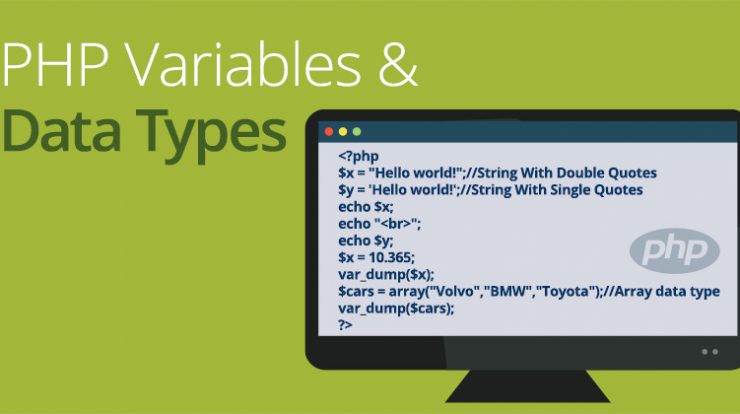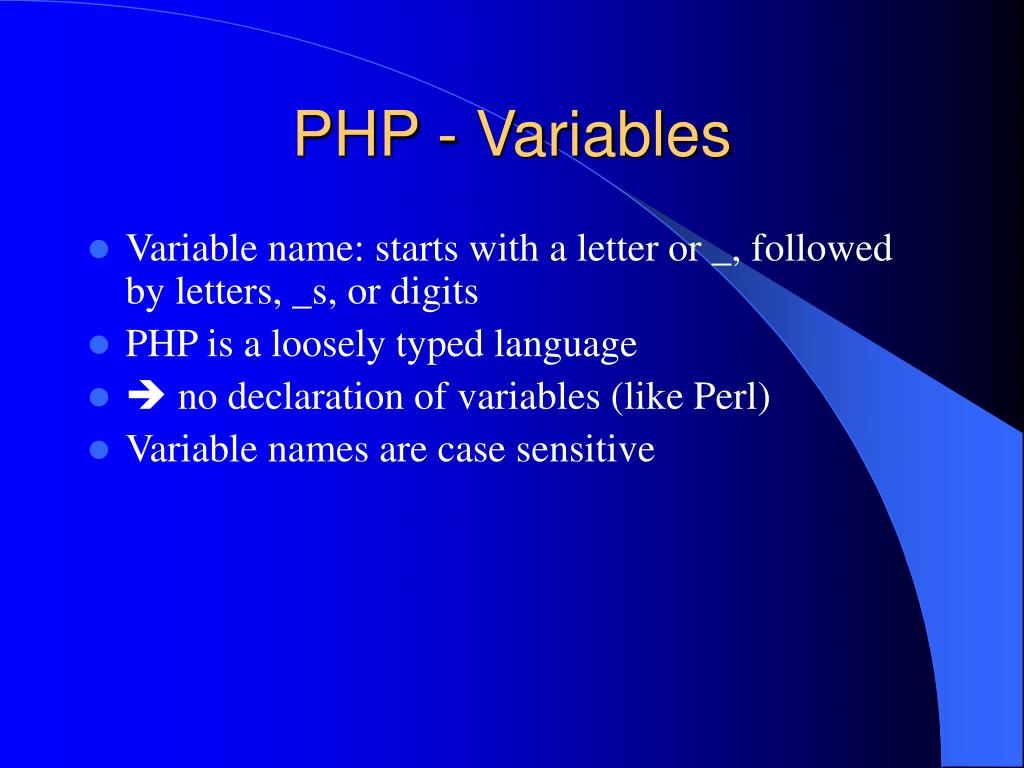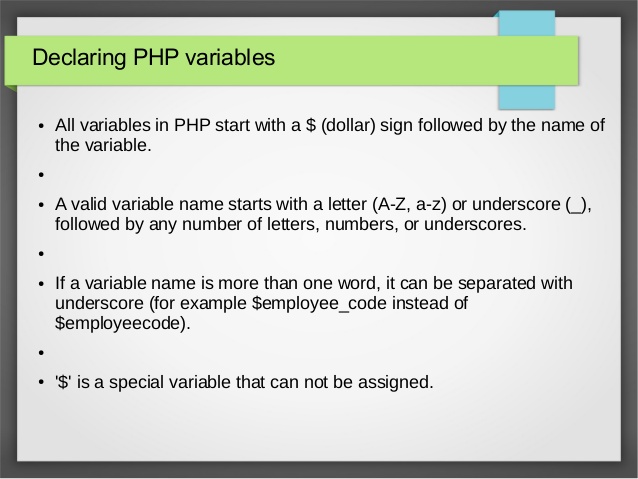
What is Variable?

A variable is a computer memory name representing knowledge in every programming language. Variables are one of the many computer programme components. The $ sign followed by his signature, e.g. $myVariable, can be used to declare a variable in PHP.

Consider the following PHP code for storing and printing data into two variables. The variable $str contains a string and the variable $num contains a data type integer. Later in the class, we will talk about strings and integer.
| <?php | |
| $str = "I will be back by"; | |
| $num = 5; | |
| echo $str; | |
| echo " "; // Output: I will be back by | |
| echo $num; // Output: 5 | |
| ?> |
A variable is the key way to store information in the centre of PHP. Here are the key things you need to know about PHP variables.
- The leading dollar ($) symbol is used for all variables in PHP.
- The variable value is the value of its last task.
- The = operator, vector on the left and the expression evaluated on the right are allocated to the Variables.
- Until assignment, variables can be declared but do not need to be declared.
- PHP variable doesn’t have inherent types – a variable doesn’t decide if it’s going to save a number or string of characters in advance.
- The values of default values are used prior to assignment.
- PHP does a decent job of translating types automatically if needed.
- PHP is Perl-like variables

Assigning Variables:
The classification of variable is straightforward. Only type the name and apply a single equal sign (=), then the expression we want this variable to be assigned.
Example:- $pi=3 + 0.1489;
Reassigning Variables:
After a value has been assigned to the variable, you can reassign the values to the same variable name if they need to be modified at the later stages of the programme.
Example:– $my_num_var = “this should be a number – hope it is reassigned later”; $my_num_var = 5;
Unassigned Variables:
Many languages report an error if you want to use the variables before any value is allocated. However, the PHP addresses these unassigned variables. With PHP you can use the usual error reporting settings without reporting any errors. If the variables not allocated are advised, the error reporting level is assigned to E ALL from the standard error reporting level.
There are two way:-
1. The error-report(E ALL) sentence at the top of the script is integrated.
2. By changing the php.ini file to set the default level.
Default Values:
PHP assigns the default default value if you don’t move the parameters in the functions.
1. PHP variables have no inherent forms.
2. A vector does not know in advance whether a number or string of characters will be saved.
3. The variable sort is interpreted in accordance with the sense in which it is used.
Limitations in Variable Naming: As with other programming languages, PHP has no restriction on variable name length. A letter or an underline must be used for the variable name. A mixture of letters, numbers and underscores should include the variable name. Other features, like *, +, #, @, and if used, the error is not allowed.
What is Data types?

Their sizes can change along with the names of the variables. You can use a variety of data types for the variables in most programming languages (like C++ and Java). However, PHP does not provide clear definitions of type, but the variable type shall be defined by the form or type of value it is applied to.

For various purposes, there are various data types, e.g. null, binary, integer, float, string, object, property and an array. PHP has eight forms of data that we use to make our variables. A short description of the categories is given below.

- Integers − There are whole numbers, including 4195, without a decimal point.
- Doubles − Floating points are numbers such as 3.14159 or 49.1
- Booleans − Have either true or false only two possible values.
- NULL − It has only one value: NULL, is a special kind.
- Strings − There are character strings, such as ‘PHP supports string operations.’
- Arrays − Collections of other values are called and indexed.
- Objects − There are instances of programming classes that can package other class-specific values and functions.
- Resources − Special variables provide access to external PHP tools (such as database connections).
The first five are straightforward categories, whereas the two next ones (arrays and objects) are complex – the compound types will load other random types, while the plain ones cannot bundle them.
Integer:-
An integer is either positive or negative. For any number base it can be used (i.e., decimal, hexadecimal, octal, etc.). Platform depends on the size of an integer.
Rules for integer:
- An integer can be either positive or negative.
- An integer must not contain decimal point.
- Integer can be decimal (base 10), octal (base 8), or hexadecimal (base 16).
- The range of an integer must be lie between 2,147,483,648 and 2,147,483,647 i.e., -2^31 to 2^31.
No unsigned integers are supported by PHP. This means an integer may be positive or negative because each integer contains positive or negative facts. Consider the code widget below:
| <?php | |
| $negative = -3; // negative | |
| $zero = 0; // zero (can also be null or false (as boolean) | |
| $positive = 123; // positive decimal | |
| $zeroPos = 0123; //0 prefix is used to specify octal - octal value = 83 decimal | |
| $hex = 0xAB; //0x prefix is used to specify hexadecimal - hexadecimal value = 171 decimal | |
| $bin = 0b1010; // 0b prefix is used to specify binary - binary value = 10 decimal | |
| var_dump($negative, $zero, $positive, $zeroPos, $hex, $bin); | |
| ?> |
Example:-
| <?php | |
| $dec1 = 34; | |
| $oct1 = 0243; | |
| $hexa1 = 0x45; | |
| echo "Decimal number: " .$dec1. "</br>"; | |
| echo "Octal number: " .$oct1. "</br>"; | |
| echo "HexaDecimal number: " .$hexa1. "</br>"; | |
| ?> |
Output:–

Doubles:-
3.14159 or 49.1 are like these. By design, the number of decimal points required for printing is doubled. The code − for instance.
| <?php | |
| $many = 2.2888800; | |
| $many_2 = 2.2111200; | |
| $few = $many + $many_2; | |
| print("$many + $many_2 = $few <br>"); | |
| ?> |
Output:–

Boolean:-
They are either true or false only for two possible values. PHP contains a few constants, which can be used particularly for Booleans: TRUE and FALSE.
| <?php | |
| // ignore the if and else for now. We'll study more about them later. | |
| $foo = true; | |
| if ($foo) { | |
| echo "true"; | |
| } else { | |
| echo "false"; | |
| } | |
| ?> |
To manage the flow of text, booleans may be used. Take an example of the following code fragment. If you don’t know the grammar, you will find out more in a later lesson on whether or not. Declaration:
Example:-
Output:–

Interpreting other types as Booleans:-
These are the rules for establishing the “fact” of any value that is not Boolean already –
- It is wrong if it is equal to zero and right otherwise if the value is an integer.
- If this number is a number, then it’s wrong if this string is empty or is the string “0,” and otherwise it’s real.
- Form NULL values are often incorrect.
- If the value is an array, it is wrong because there are no other values, and otherwise it is valid. For an object, it means a value that has been assigned a value to a member variable.
- Responsible tools are real (although some functions that return resources when they are successful will return FALSE when unsuccessful).
- Don’t use Booleans twice.
NULL:-
Null is a special class of data with only one value: NULL. There is a convention to write it as it is case-sensitive in major letters. A vector with no value was specified by a special data form NULL. Any vector may have null allocated.
| <?php | |
| $nl = NULL; | |
| echo $nl; //it will not give any output | |
| ?> |
The assignment of null to an attribute invalidates it and if used, its value is unspecified or zero. The variable is memory transparent and the garbage collector removes the variable.
A variable with the following properties has been assigned to NULL –
1. In a boolean setting it evaluates FALSE.
2. When the IsSet() function is evaluated, it returns FALSE.
String
Strings:-
A string is a non-numeric category of data. It contains letters, numbers and even special characters. Either inside a single quote or a double quote, string values must be used. However, they are handled accordingly. See the example below for clarification:
| <?php | |
| $foo = "I am a string"; | |
| echo $foo; // outputs "I am a string" | |
| echo "\n"; | |
| echo $foo[3]; // Prints 'm', the third character of the string in $foo. | |
| ?> |
Example:-
| <?php | |
| $company = "Javatpoint"; | |
| //both single and double quote statements will treat different | |
| echo "Hello $company"; | |
| echo "</br>"; | |
| echo 'Hello $company'; | |
| ?> |
Output:–

Arrays:-
A table is like a significance list. The simplest type of an array is indexed by an integer and the first member is indexed by an index 0.
| <?php | |
| $foo = array(1, 2, 3); // An array of integers created using array fucntion | |
| $bar = ["A", true, 123 => 5]; // Short array syntax, PHP 5.4+ | |
| echo $bar[0]; // Returns "A" | |
| echo "\n"; | |
| echo $bar[1]; // Returns 1 for true | |
| echo "\n"; | |
| echo $bar[123]; // Returns 5 | |
| // echo $bar[1234]; // uncommenting this line will give an error because 1234 is inaccessable | |
| ?> |
Arrays may also match a value with a key rather than an integer index. In PHP, all arrays are associative arrays, but we typically mean one that includes one or more keys which are not integrals when we specifically refer to an associative array.
| <?php | |
| $array = array(); | |
| $array["foo"] = "bar"; | |
| $array["bar"] = "quux"; | |
| $array[42] = "hello"; | |
| echo $array["foo"]; // Outputs "bar" | |
| echo "\n"; | |
| echo $array["bar"]; // Outputs "quux" | |
| echo "\n"; | |
| echo $array[42]; // Outputs "hello" | |
| ?> |
Example:-
| <?php | |
| $bikes = array ("Royal Enfield", "Yamaha", "KTM"); | |
| var_dump($bikes); //the var_dump() function returns the datatype and values | |
| echo "</br>"; | |
| echo "Array Element1: $bikes[0] </br>"; | |
| echo "Array Element2: $bikes[1] </br>"; | |
| echo "Array Element3: $bikes[2] </br>"; | |
| ?> |
Output:–

Objects:-
Objects are the user class instances and can store values and functions respectively. They have to be declared directly.
Example:-
| <?php | |
| class bike { | |
| function model() { | |
| $model_name = "Royal Enfield"; | |
| echo "Bike Model: " .$model_name; | |
| } | |
| } | |
| $obj = new bike(); | |
| $obj -> model(); | |
| ?> |
Output:–

Resources:-
The same PHP data form is not resources. Basically, certain function calls or external PHP references are stored. For instance – calling a database. The resource is external.
Email- contact@devopsschool.com

 Starting: 1st of Every Month
Starting: 1st of Every Month  +91 8409492687
+91 8409492687  Contact@DevOpsSchool.com
Contact@DevOpsSchool.com
 by
by 